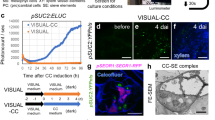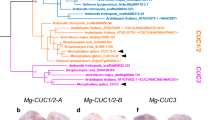Abstract
Key message
A fluorescent protein visualized distributions of cell layers in floral organs of chrysanthemum using transgenic periclinal chimeras carrying a gene encoding a fluorescent compound.
Abstract
Plant meristems have three cell layers: the outermost layer (L1), the second layer (L2), and the inner layer (L3). The layers are maintained during development but there is limited knowledge of the details of cell layer patterns within floral organs. In this study, we visualized the distributions of cell layers in floral organs of chrysanthemum using periclinal chimeras carrying a gene encoding a fluorescent compound in the L1 or the L2/L3 layers. The L1 layer contributed most of the epidermal cells of organs including the receptacle, petal, anther, filament, style, stigma, and ovule. The transmitting tissue in the pistil and most of the internal area of the ovule were also derived from the L1. In crossing experiments, no progeny of the L1-chimeric plants showed fluorescence, indicating that the germ cells of chrysanthemum are not derived from the L1 layer. Since anthocyanin pigment is present only in the L1-derived epidermal cells of petals, L1-specific gene integration could be used to alter flower color in commercial cultivars, with a reduced risk of transgene flow from the transgenic chrysanthemums to wild relatives.





Similar content being viewed by others
References
Aida R, Sasaki K, Ohtsubo N (2016) Production of chrysanthemum periclinal chimeras through shoot regeneration from leaf explants. Plant Biotechnol 33:45–49. https://doi.org/10.5511/plantbiotechnology.15.1127a
Aida R, Douzono M, Yoshioka S, Noda N, Tsuda M, Ohsawa R (2018) Inheritance of bluish flower color of transgenic chrysanthemum by interspecific hybrids. JARQ 52:339–345. https://doi.org/10.6090/jarq.52.339
Burk LG, Stewart RN, Dermen H (1964) Histogenesis and genetics of a plastid-controlled chlorophyll variegation in tobacco. Am J Bot 51:713–724. https://doi.org/10.1002/j.1537-2197.1964.tb06691.x
Dermen H (1953) The pattern of tetraploidy: in the flower and fruit of a cytochimeral apple. J Heredity 44:31–40. https://doi.org/10.1093/oxfordjournals.jhered.a106347
Dermen H, Stewart RN (1973) Ontogenetic study of floral organs of peach (Prunus persica) utilizing cytochimeral plants. Am J Bot 60:283–291. https://doi.org/10.1002/j.1537-2197.1973.tb10229.x
Geier T (2012) Chimeras: properties and dissociation in vegetatively propagated plants. In: Shu Q-Y, Forster BP, Nakagawa H (eds) Plant mutation breeding and biotechnology. CABI, Wallingford, pp 191–201. https://www.fao.org/3/a-i2388e.pdf
Hraška M, Rakouský S, Čurn V (2008) Tracking of the CaMV-35S promoter performance in GFP transgenic tobacco, with a special emphasis on flowers and reproductive organs, confirmed its predominant activity in vascular tissues. Plant Cell Tissue Organ Cult 94:239–251. https://doi.org/10.1007/s11240-007-9312-6
Marcotrigiano M, Bernatzky R (1995) Arrangement of cell layers in the shoot apical meristems of periclinal chimeras influences cell fate. Plant J 7:193–202. https://doi.org/10.1046/j.1365-313X.1995.7020193.x
Masuda H, Takenaka Y, Yamaguchi A, Nishikawa S, Mizuno H (2006) A novel yellowish-green fluorescent protein from the marine copepod, Chiridius poppei, and its use as a reporter protein HeLa cells. Gene 372:18–25. https://doi.org/10.1016/j.gene.2005.11.031
Nakamura N, Fukuchi-Mizutani M, Katsumoto Y, Togami J, Senior M, Matsuda Y, Furuichi K, Yoshimoto M, Matsunaga A, Ishiguro K, Aida M, Tasaka M, Fukui H, Tsuda S, Chandler S, Tanaka Y (2011) Environmental risk assessment and field performance of rose (Rosa×hybrida) genetically modified for delphinidin production. Plant Biotech 28:251–261. https://doi.org/10.5511/plantbiotechnology.11.0113a
Nakata M, Tanaka R, Tanigichi K, Shimotomai N (1987) Species of wild Chrysanthemums in Japan: cytological and cytogenetical view on its entity. Acta Phytotax Geobot 38:241–259. 10.18942/bunruichiri.KJ00002992261
Nakata M, Sudo A, Taniguchi K (2001) A follow-up survey on the population of Dendranthema japonicum var. wakasaense where the hybrids with garden chrysanthemum were discovered 14 years ago. Jpn J Conserv Ecol 6:21–27. 10.18960/hozen.6.1_21
Noda N, Yoshioka S, Kishimoto S, Nakayama M, Douzono M, Tanaka Y, Aida R (2017) Generation of blue chrysanthemums by anthocyanin B-ring hydroxylation and glucosylation and its coloration mechanism. Sci Adv 3:e1602785. https://doi.org/10.1126/sciadv.1602785
Ohashi H, Yonekura K (2004) New combination in Chrysanthemum (Compositae-Anthemideae) of Asia with a list of Japanese species. J Jpn Bot 79:186–195. https://www.jjbotany.com/pdf/JJB_079_186_195.pdf
Sasaki K, Kato K, Mishima H, Furuichi M, Waga I, Takane K, Yamaguchi H, Ohtsubo N (2014) Generation of fluorescent flowers exhibiting strong fluorescence by combination of fluorescent protein from marine plankton and recent genetic tools in Torenia fournieri Lind. Plant Biotechnol 31:309–318. https://doi.org/10.5511/plantbiotechnology.14.0907a
Satina S (1944) Periclinal chimeras in Datura in relation to development and structure (A) of the style and Stigma (B) of calyx and corolla. Am J Bot 31:493–502. https://doi.org/10.1002/j.1537-2197.1944.tb08063.x
Satina S (1945) Periclinal chimeras in Datura in relation to the development and structure of the ovule. Am J Bot 32:72–81. https://doi.org/10.1002/j.1537-2197.1945.tb05089.x
Satina S, Blakeslee AF (1941) Periclinal chimeras in Datura stramonium in relation to development of leaf and flower. Am J Bot 28:862–871. https://doi.org/10.1002/j.1537-2197.1941.tb11017.x
Satina S, Blakeslee AF (1943) Periclinal chimeras in Datura in relation to development of carpel. Am J Bot 30:453–462. https://doi.org/10.1002/j.1537-2197.1943.tb14786.x
Satina S, Blakeslee AF, Avery AG (1940) Demonstration of the three germ layers in the shoot apex of Datura by means of induced polyploidy in periclinal chimeras. Am J Bot 27:895–905. https://doi.org/10.1002/j.1537-2197.1940.tb13952.x
Schmülling T, Schell J (1993) Transgenic tobacco plants regenerated from leaf disks can be periclinal chimeras. Plant Mol Biol 21:705–708. https://doi.org/10.1007/BF00014554
Shibata M, Kawata J (1986) Chimerical structure of the marble sport series in chrysanthemum. In: Kitaura K, Akihama T, Kukimura H, Nakajima K, Horie M, Kozaki I (eds) Development of new technology for identification and classification of tree crops and ornamentals. Fruit Tree Research Station, Tsukuba, pp 47–52
Stewart RN, Burk LG (1970) Independence of tissues derived from apical layers in ontogeny of the tobacco leaf and ovary. Am J Bot 57:1010–1016. https://doi.org/10.1002/j.1537-2197.1970.tb09902.x
Stewart RN, Dermen H (1970) Somatic genetic analysis of the apical layers of chimeral sports in chrysanthemum by experimental production of adventitious shoots. Am J Bot 57:1061–1071. https://doi.org/10.1002/j.1537-2197.1970.tb09910.x
Stewart RN, Dermen H (1979) Ontogeny in monocotyledons as revealed by studies of the developmental anatomy of periclinal chloroplast chimeras. Am J Bot 66:47–58. https://doi.org/10.1002/j.1537-2197.1979.tb06192.x
Tilney-Bassett RAE (1963) The structure of periclinal chimeras. Heredity 18:265–285. https://doi.org/10.1038/hdy.1963.30
Tilney-Bassett RAE (1986) Plant chimeras. Edward Arnold, London
Wilkinson JE, Twell D, Lindsey K (1997) Activities of CaMV 35S and nos promoters in pollen: implications for field release of transgenic plants. J Exp Bot 48:265–275. https://doi.org/10.1093/jxb/48.2.265
Acknowledgements
We thank Mr. Hiroshi Mishima and Dr. Iwao Waga (NEC Solution Innovators, Ltd.), Dr. Makio Furuichi (NEC Corporation), Dr. Ken-ichi Takane (Inplanta Innovations Inc.), and Dr. Ko Kato (Nara Institute of Science and Technology) for granting us permission to use the CpYGFP vector. This work was supported in part by JSPS KAKENHI Grant number 17H03767.
Author information
Authors and Affiliations
Contributions
R. A. and K. S. designed the study. R. A. performed most of the experiments. S. Y. and N. N maintained the plants used in the study. R. A. wrote the first draft, and K. S., S. Y., and N. N reviewed and rewrote the manuscript.
Corresponding author
Ethics declarations
Conflict of interest
The authors declare that they have no conflict of interest.
Additional information
Communicated by Da-Bing Zhang.
Publisher's Note
Springer Nature remains neutral with regard to jurisdictional claims in published maps and institutional affiliations.
Rights and permissions
About this article
Cite this article
Aida, R., Sasaki, K., Yoshioka, S. et al. Distribution of cell layers in floral organs of chrysanthemum analyzed with periclinal chimeras carrying a transgene encoding fluorescent protein. Plant Cell Rep 39, 609–619 (2020). https://doi.org/10.1007/s00299-020-02518-y
Received:
Accepted:
Published:
Issue Date:
DOI: https://doi.org/10.1007/s00299-020-02518-y




